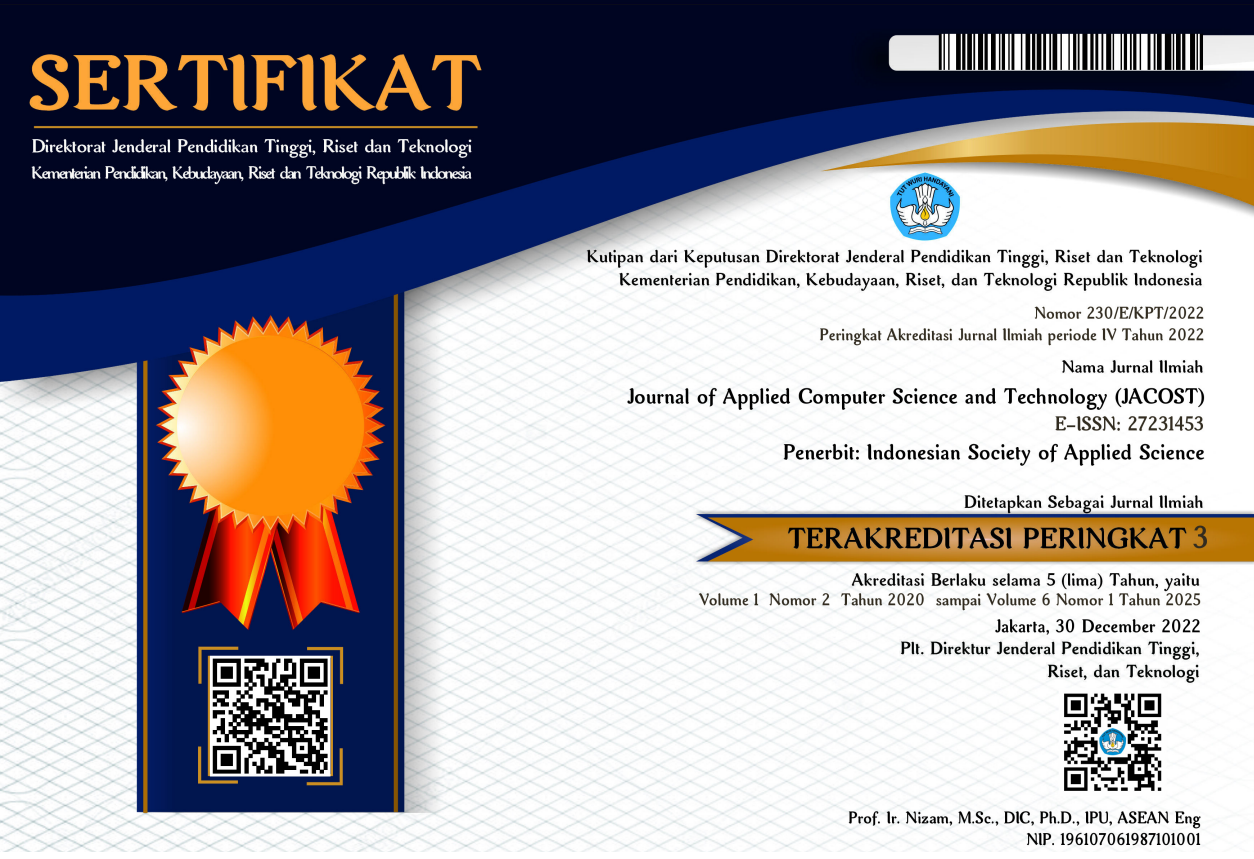Implementasi Algoritma Naive Bayes Untuk Memprediksi Tingkat Penyebaran Covid-19 Di Indonesia
DOI:
https://doi.org/10.52158/jacost.v1i1.9Keywords:
Covid-19, Naïve Bayes, Aplikasi WEKAAbstract
The COVID-19 pandemic is the first and foremost health crisis in the world. Coronavirus is a collection of viruses from the subfamily Orthocronavirinae in the Coronaviridae family and the order of Nidovirales. This group of viruses that can cause disease in birds and mammals, including humans. In humans, coronaviruses cause generally mild respiratory infections, such as colds, although some forms of disease such as; SARS, MERS, and COVID-19 are more deadly. Anticipating and reducing the number of corona virus sufferers in Indonesia has been carried out in all regions. Among them by providing policies to limit activities out of the house, school activities laid off, work from home (work from home), even worship activities were laid off. This has become a government policy based on considerations that have been analyzed to the maximum, of course. Therefore this research was carried out as an anticipation step towards the Covid-19 pandemic by predicting the spread of Covid-19, especially in Indonesia. The research method applied in this research is problem analysis and literature study, collecting data and implementation. The application of the naive bayes method is expected to be able to predict the spread rate of COVID-19 in Indonesia. The results of the Naive Bayes method classification show that 16 data from 33 data were tested in Covid-19 cases per province with an accuracy of 48.4848%, where of the 33 data tested in the Covid-19 case per province tested there were 16 data that were successfully classified correctly.
Downloads
References
Mona, Nailul. 2020. Konsep Isolasi Dalam Jaringan Sosial Untuk Meminimalisasi Efek Contagious (Kasus Penyebaran Virus Corona Di Indonesia). Jurnal Sosial Humaniora Terapan (JSHT), 2(2), pp. 117. doi: https://doi.org/10.7454/jsht.v2i2.86.
Saleh, Alfa. 2015. Implementasi Metode Klasifikasi Naive Bayes Dalam Memprediksi Besarnya Penggunaan Listrik Rumah Tangga. Creative Information Technology Journal (Citec Journal), 2(3), pp. 208-216. doi: https://doi.org/10.24076/citec.2015v2i3.49.
Bustami. 2013. Penerapan Algoritma Naive Bayes Untuk Mengklasifikasi Data Nasabah Asuransi. TECHSI (Jurnal Penelitian Teknik Informatika), 3(2), pp. 127-146. doi: https://doi.org/10.29103/techsi.v5i2.154.
Ridwan, M., Suyono, H., Sarosa, M. 2013. Penerapan Data Mining untuk Evaluasi Kinerja Akademik Mahasiswa Menggunakan Algoritma Naive Bayes Classifier. Jurnal EECCIS,
(7), pp. 59-64.
Mujiasih, S. 2011. Pemanfaatan Data Mining Untuk Prakiraan Cuaca. Jurnal Meteorologi dan Geofisika, 12(2), pp. 189-195. doi: http://dx.doi.org/10.31172/jmg.v12i2.100
Yunus, N. R., & Rezki, Annisa. 2020. Kebijakan Pemberlakuan Lockdown Sebagai Antisipasi Penyebaran Corona Virus Covid-19. SALAM; Jurnal Sosial & Budaya Syar-i, 7(3), pp. 227-238. doi: https://doi.org/10.15408/sjsbs.v7i3.15083
Purwanto, A., Pramono, R., Asbari, M., Santoso, P. B., Wijayanti, L. M., Hyun, C. C., Putri, R. S. 2020. Studi Eksploratif Dampak Pandemi COVID-19 Terhadap Proses Pembelajaran Online di Sekolah Dasar. EduPsyCouns: Journal of Education, Psychology and Counseling, 2(1), pp. 1-12.
Pratiwi, R. W., & Nugroho, Y. S. 2016. Prediksi Rating Film Menggunakan Metode Naive Bayes. Jurnal Teknik Elektro, 8(2), pp. 60-63. doi: https://doi.org/10.15294/jte.v8i2.7764.
Wasiati, H., & Wijayanti, D. Sistem Pendukung Keputusan Penentuan Kelayakan Calon Tenaga Kerja Indonesia Menggunakan Metode Naive Bayes (Studi Kasus: Di P.T. Karyatama Mitra Sejati Yogyakarta). IJNS – Indonesian Journal on Networking and Security, 3(2), pp. 45-51. doi: http://dx.doi.org/10.1123/ijns.v3i2.154.
World Health Organization. (2019). Coronavirus . Retrieved from World Health Organization: https://www.who.int/healthtopics/coronavirus
Fajar, Muhammad. 2020. Estimasi Angka Reproduksi Novel Coronavirus (COVID-19) Kasus Indonesia. Retrieved from https://www.researchgate.net/publication/340248900_ESTIMATION_OF_COVID_19_REPRODUCTIVE_NUMBER_CASE_OF_INDONESIA_Estimasi_Angka_Reproduksi_Novel_Coronavirus_COVID-19_Kasus_Indonesia. doi: 10.13140/RG.2.2.32287.92328 (diakses tanggal 15 Mei 2020)
https://covid19.go.id/peta-sebaran (diakses tanggal 15 Mei 2020)
DR. Derwin Suhartono, S.KOM., M.T.I. 2018. Weka: Software untuk Memahami Konsep Data Mining. https://socs.binus.ac.id/2018/11/29/weka-software-untuk-memahami-konsep-data-mining/. (diakses tanggal 29 November 2018)
Khalimy, Muiz. 2020. Menghitung Naive Bayes dengan Excel Atribut Data Numerik. https://pengalaman-edukasi.blogspot.com/2020/04/menghitung-naive-bayes-dengan-excel.html (diakses tanggal 16 April 2020)
Widianto, Mochammad Haldi. 2019. Algoritma Naive Bayes. https://binus.ac.id/bandung/2019/12/algoritma-naive-bayes/. (diakses tanggal 23 Desember 2019).
Downloads
Published
Issue
Section
License
Pernyataan Hak Cipta dan Lisensi
Dengan mengirimkan manuskrip ke Journal of Applied Computer Science and Technology (JACOST), penulis setuju dengan kebijakan ini. Tidak diperlukan persetujuan dokumen khusus.
- Hak cipta pada setiap artikel adalah milik penulis.
- Penulis mempertahankan semua hak mereka atas karya yang diterbitkan, tak terbatas pada hak-hak yang diatur dalam laman ini.
- Penulis mengakui bahwa Journal of Applied Computer Science and Technology (JACOST) sebagai yang pertama kali mempublikasikan dengan lisensi Creative Commons Atribusi 4.0 Internasional (CC BY-SA).
- Penulis dapat memasukan tulisan secara terpisah, mengatur distribusi non-ekskulif dari naskah yang telah terbit di jurnal ini kedalam versi yang lain (misal: dikirim ke respository institusi penulis, publikasi kedalam buku, dll), dengan mengakui bahwa naskah telah terbit pertama kali pada Journal of Applied Computer Science and Technology (JACOST);
- Penulis menjamin bahwa artikel asli, ditulis oleh penulis yang disebutkan, belum pernah dipublikasikan sebelumnya, tidak mengandung pernyataan yang melanggar hukum, tidak melanggar hak orang lain, tunduk pada hak cipta yang secara eksklusif dipegang oleh penulis.
- Jika artikel dipersiapkan bersama oleh lebih dari satu penulis, setiap penulis yang mengirimkan naskah menjamin bahwa dia telah diberi wewenang oleh semua penulis bersama untuk menyetujui hak cipta dan pemberitahuan lisensi (perjanjian) atas nama mereka, dan setuju untuk memberi tahu rekan penulis persyaratan kebijakan ini. Journal of Applied Computer Science and Technology (JACOST) tidak akan dimintai pertanggungjawaban atas apa pun yang mungkin timbul karena perselisihan internal penulis.
Lisensi :
Journal of Applied Computer Science and Technology (JACOST) diterbitkan berdasarkan ketentuan Lisensi Creative Commons Atribusi 4.0 Internasional (CC BY-SA). Lisensi ini mengizinkan setiap orang untuk :.
- Berbagi — menyalin dan menyebarluaskan kembali materi ini dalam bentuk atau format apapun;
- Adaptasi — menggubah, mengubah, dan membuat turunan dari materi ini untuk kepentingan apapun.
Lisensi :
-
Atribusi — Anda harus mencantumkan nama yang sesuai, mencantumkan tautan terhadap lisensi, dan menyatakan bahwa telah ada perubahan yang dilakukan. Anda dapat melakukan hal ini dengan cara yang sesuai, namun tidak mengisyaratkan bahwa pemberi lisensi mendukung Anda atau penggunaan Anda.
-
BerbagiSerupa — Apabila Anda menggubah, mengubah, atau membuat turunan dari materi ini, Anda harus menyebarluaskan kontribusi Anda di bawah lisensi yang sama dengan materi asli.

















